'The future is now' in new skin cancer diagnosis technology
Cancer Center collaboration connects the lab with the clinic to develop and test portable skin cancer diagnostic device.
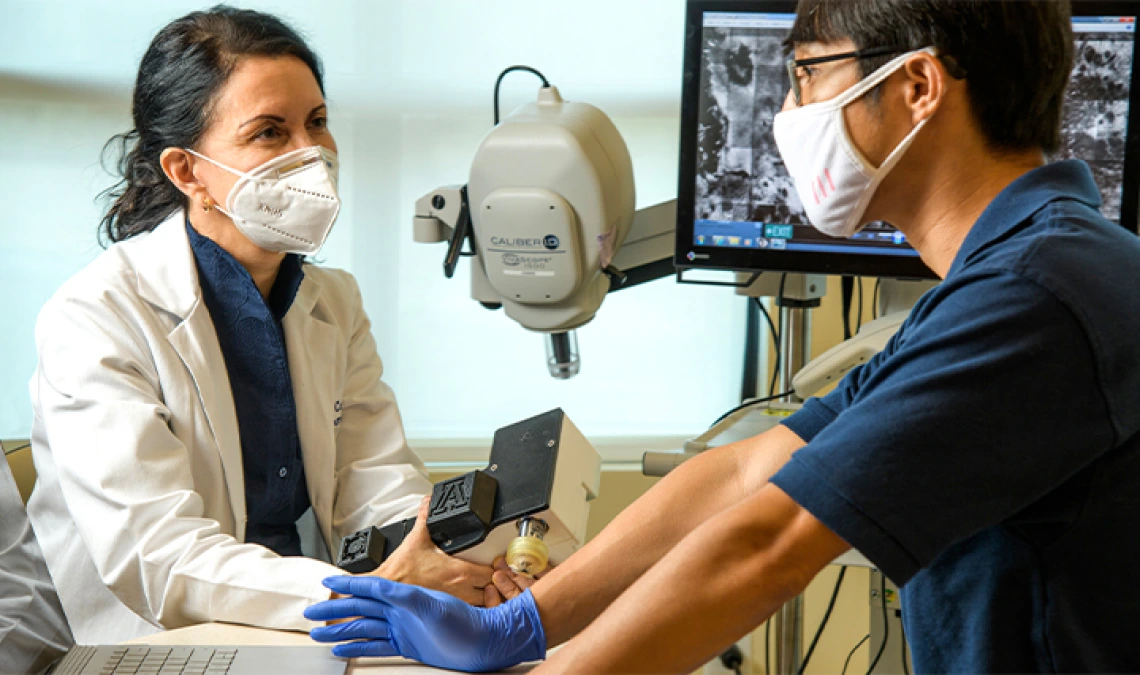
Clara Curiel-Lewandrowski, MD, and Dongkyun Kang, PhD, are collaborating to create a portable, less expensive version of a skin cancer diagnostic microscope.
The sun’s harmful ultraviolet rays pose elevated risks for skin cancer in the desert southwest, but University of Arizona Health Sciences researchers at the UArizona Cancer Center are using their unique position to address this disease with new technology.
The Center’s Skin Cancer Institute has a novel device that provides noninvasive imaging of the skin called reflectance
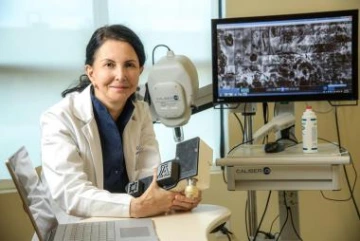
Clara Curiel Lewandrowski, MD, in front of a screen showing the images produced by the portable confocal microscope in development at the University of Arizona.
confocal microscopy (RCM). It allows doctors to quickly and safely diagnose many skin cancers and monitor responses to treatment without a biopsy.
Clara Curiel-Lewandrowski, MD, co-director of the Skin Cancer Institute and interim dermatology division chief at the College of Medicine – Tucson, brought the technology to the university. She is now working with Dongkyun Kang, PhD, co-leader of the Cancer Imaging Program, to create a version of the device that is more accessible to doctors trained in skin cancer diagnosis.
Dr. Curiel saw the potential of RCM in the mid-1990s as a research fellow at the Wellman Laboratories of Photomedicine at Massachusetts General Hospital. Though she was focused on a separate physics project, Dr. Curiel was drawn to the work of Salvador González, MD, who was building a confocal microscope right there in the lab.
“I was watching as they invented it,” Dr. Curiel said. “They were literally putting it together on a big table in the lab with all of the lenses, mirrors, and the lasers. They were calculating the reflective indices of multiple structures in the skin and how to reconstruct the images.”
The technology “treasure box”
By 2001, Dr. Curiel held a faculty position at Harvard University and her work was more focused on skin cancer. It was there she realized confocal microscopy may be able to help effectively treat lentigo maligna melanoma, an early form of melanoma often found around the head and neck of patients with significant sun damage. Because the malignant cells aren’t visible to surgeons, many of these patients undergo more than one surgery.
curiel_clinic-confocal_microscope-72-inline.jpg
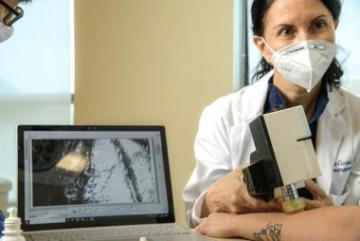
Clara Curiel-Lewandrowski, MD, takes an image of a person’s arm with the portable version of a confocal microscope. It provides a “map” of the skin for a doctor to use in diagnosing or treating skin cancer.
“That is when I reached out to Salvador,” Dr. Curiel said. “I said, ‘How about we start applying confocal microscopy to lentigo maligna type lesions and map the margins for the surgeons?’ If successful, we can increase the likelihood of removing the entire lesion the first time around.”
The results were positive, according to Dr. Curiel. The confocal microscope produced a “map” for surgeons ahead of the procedure. For most patients, subsequent procedures were not necessary.
The RCM allows the operator, such as a dermatologist, to examine, layer by layer, an abnormal spot or lesion by steadily pressing the lens into the skin. To do this, the microscope directs a narrow laser light on a specific spot on the skin with vertical and horizontal scanning capability, resulting in a real-time diagnosis that can, in some cases, bypass the need for a biopsy and lead to same-day treatment.
“When you place the confocal microscope (on the skin), it is no different than opening a treasure box,” Dr. Curiel said. “You know, it's like, ‘oh my goodness,’ all of these clues were here and I couldn't even see them before. Beyond the capability to allow for immediate diagnosis, RCM is also valuable to monitor a lesion over time, and to non-invasively determine a response to treatment.”
Adding to the Cancer Center toolbox
A few years later, Dr. Curiel came to UArizona Health Sciences and was determined to introduce the instrument here. In 2014, she purchased the university’s first RCM instrument with funding from the UArizona Technology and Research Initiative Fund (TRIF).
dk_lab_klh9651-inline.jpg
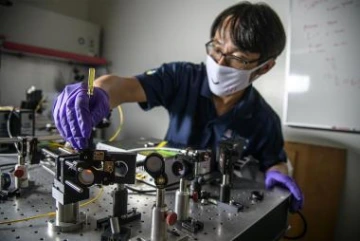
Dongkyun Kang, PhD, aligns laser optics to increase the light power of the portable, skin cancer diagnostic microscope in development.
She now works with Dr. Kang, who was recruited from the Wellman Laboratories to explore the next generation of the technology – a handheld or portable version. The current instrument costs more than $80,000, making it too expensive for many clinical practice settings.
The technology is made with very sophisticated electrical and optical components, according to Dr. Kang, an assistant professor of optical sciences and biomedical engineering at the James C. Wyant College of Optical Sciences. His lab has been focused on developing a portable confocal microscope (PCM) using an inexpensive near-infrared LED to lower the manufacturing costs and make the device more practical for clinical use.
“One of the benefits of having our own instrument is that other investigators here can compare their imaging technology to an industry gold standard holding FDA approval for skin assessment. That gives us the capability to provide feedback to the investigators and improve the technology through a series of feedback loops,” Dr. Curiel said.
Making the device widely available
Last year, through Tech Launch Arizona, Dr. Kang’s lab licensed three inventions to a startup company in California, which may seek development of a commercial iteration of Dr. Kang’s device. A portable device could look something like a large pen and cost closer to $1,000. Dr. Kang has also tested a smartphone PCM device at the Infectious Diseases Institute (IDI) in Uganda.
“The goal is to make it widely available not just to dermatologists, but to practitioners around the world.” Dr. Kang said. “Collaboration is very important so that we are making this technology work in the context of the clinical setting. I work very closely with Clara and also my collaborators with the project in Uganda to see what we can improve.”
curiel_clinic-confocal_microscope-59-inline.jpg
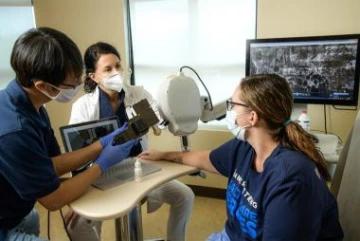
Dr. Curiel aims the large confocal microscope, while Dr. Kang aligns the portable version in development to compare the imaging quality.
Drs. Curiel and Kang, both members of the BIO5 Institute, continue to advance the PCM device, routinely testing and comparing its performance to the commercial RCM unit and other technologies available.
"For skin cancer, I view confocal microscopy as the future is now,” Dr. Curiel said. “We are poised to be the institution that changes the standard of care in skin cancer prevention, diagnosis, and minimally invasive therapeutics. Our advantages are that we have a large number of skin cancer cases and we have the technology to initiate the shift in practice. It is up to us to embrace the change.”
Photo gallery can be found here.



